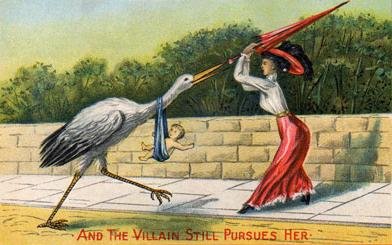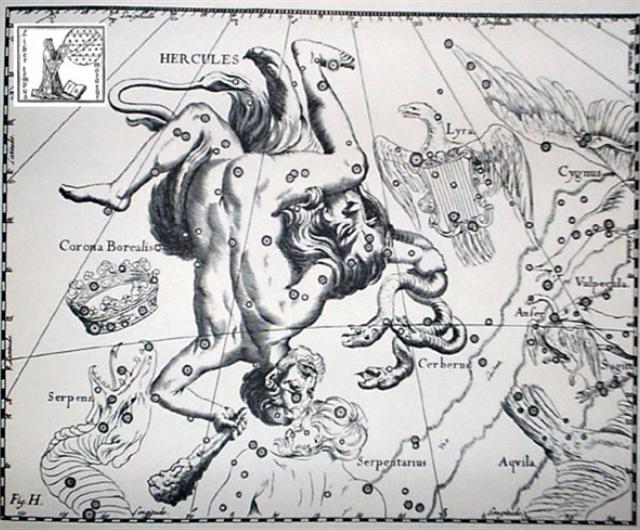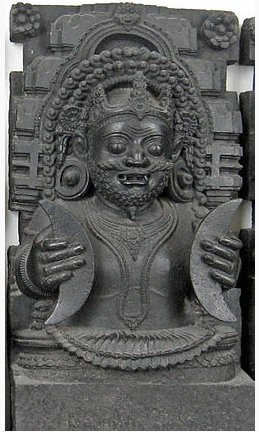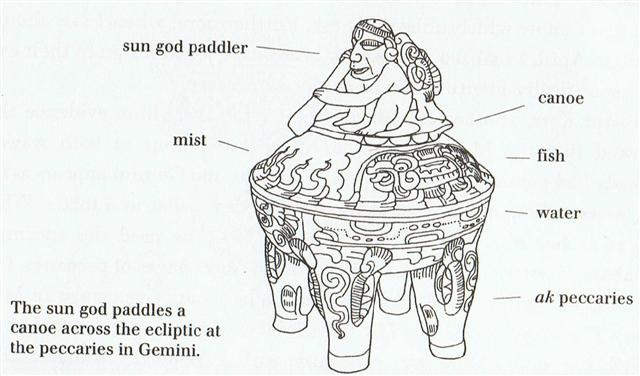7-1. Number 39, of the stolen
variants of uhi, could perhaps be connected with the movement of
the Sun from
one hemisphere to the other.
... It grew light [he otea] and Teke went out [he
ea a Teke ki haho] in the twilight to urinate [i te
po ana mimi]. [E:59]
Then [hokoou] Teke called
out from the door, from outside [o haho], 'Hey you!
Hurry out to our yams! [ka ea mai koe ki te uhi]'
The digging of the yams was over [ka
pae ana te keri] and the thieves had stolen [ku toke]
the yams.
Earlier Teke's men had placed [ku noho era] the
baskets in front of the house [i mua i te hare],
every one of his baskets (? ka paepae tahi ro). Maeha
came out of the house, saw the yam (plantation) [he ui i
te uhi], and said, 'The yams are gone because of the
theft for the king.'
[ku pae ana te uhi.i te kori mo te Ariki] ...
[E:60]
As we should
remember, the act of urinating
coincided also with the arrival to Easter Island of king
Hotu A Matua:
... On the fifteenth day of the month of
October (tangaroa uri), Nonoma left the house [he
ea mai roto i te hare] during the night [i te po]
to urinate outdoors [ki kaho.mimi]. At this
point Ira called out [he rangi] to Nonoma, 'Look at
the canoe!' Nonoma ran [he tahuti], he quickly went
to Te Hiringa Heru (a ravine in the side of the crater Rano
Kau) and looked around. There he saw the double canoe way
out near the (offshore) islets [i te motu o haho],
and the two (hulls of the canoe) were lashed together ... [E:75]

The 19th Hindu station, Mula, which I
in a way misleadingly
have referred to as 'The Root' (singular) in fact was a
bunch of roots tied together.
| 18 |
Jyeshtha
the eldest, most excellent |
α, σ, and τ
Scorpii
Antares (?) |
Circular amulet,
umbrella, earring |
249 = 241
+ 8
Nov 25 (300 + 29) |
 |
|
19 |
Mula
the root |
ε, ζ, η, θ, ι, κ,
λ, and μ Scorpii
η Scorpii (?) |
Bunch of roots
tied together, elephant goad |
259 = 249
+ 10
Dec 5 (300 +
39) |
 |
...Yam roots was the 4th item enumerated by king
Matua A
Taana:
|
1 |
60 |
Banana
shoots |
te huri maika |
|
2 |
61 |
Taro
seedlings |
te uru taro |
|
3 |
62 |
Sections of
Sugarcane |
tepupura toa |
|
4 |
63 |
Yam roots |
te uhi |
|
5 |
64 |
Sweet
potatoes |
te rau kumara |
|
6 |
65 |
Hauhau
trees |
te hauhau |
|
7 |
66 |
Paper
Mulberry trees |
te mahute |
|
8 |
67 |
Sandalwood
trees |
te naunau |
|
9 |
68 |
Toromiro
trees |
te toromiro |
|
10 |
69 |
Ferns |
te riku |
|
11 |
70 |
Rushes |
te ngaatu |
|
12 |
71 |
Yellow
roots |
te pua |
|
13 |
72 |
Tavari
plants |
te tavari |
|
14 |
73 |
Moss |
te para |
|
15 |
74 |
Nga Oho
plants |
te ngaoho |
|
16 |
75 |
Grass |
te mauku tokoa |
In the era of Bharani the Full Moon would have
been at the right ascension line of The
Prededing One in day 157, corresponding to
the place where the Sun would have been in "October 25:
|
June 5 (156 → 2 *
78) |
→ 314 / 2 |
7
(*78) |
8 |
 |
 |
 |
 |
|
Ea6-26 |
Ea6-27 |
Ea6-28 |
Ea6-29 (207) |
|
manu rere |
moa |
kua oro |
moa |
|
Oro.
1. To
flit in the air (of a bird), turning and
flying up and down. 2. To file, to
scratch, to scrub, to grind, to sharpen;
ka-oro te kumara, grind the sweet
potatoes; ka-oro te hoe, sharpen
the knife. Orooro, to rub, to
polish, to shine. Vanaga.
Oroina,
to choke on a fish bone.
Orooro,
to whet, to sharpen (horo).
Churchill. |
|
REVERSED NAKSHATRA → CLOSE TO THE FULL
MOON: |
|
Dec 4 |
5 |
6
(*260) |
7
(341 → 300 + 41) |
|
"Oct
24 |
Tagaroa Uri 25 |
26 |
27
(*220) |
|
OCT 1 |
2 |
3
(*196) |
4 |
|
17h (*258.7)
ARRAKIS = μ Draconis
(258.7) |
Mula-19 (The Root)
SABIK (The Preceding One) =
η
Ophiuchi
(259.7),
η
Scorpii (259.9) |
NODUS I =
ζ
Draconis
(260.0),
π
Herculis (260.7),
RAS ALGETHI =
α
Herculis
(260.8) |
SARIN =
δ
Herculis
(261.0),
ο
Ophiuchi (261.4)
*220.0 = *261.4 - *41.4
ALRISHA (α Piscium) |

 |
|
INVISIBLY CLOSE TO THE SUN: |
|
5h (*76.1)
ε
Leporis (76.0),
CURSA (Footstool) =
β
Eridani (76.4),
λ Eridani (76.7)
*35.0 = *76.4 - *41.4 |
μ Aurigae, μ Leporis (77.6) |
ĸ Leporis (78.0),
RIGEL (Foot) =
β
Orionis
(78.1),
Flaming Star = IC405
(78.2),
CAPELLA (Mother Goat) =
α
Aurigae (78.4),
ο
Columbae,
τ
Orionis (78.8)
*37.0 = *78.4 - *41.4
THUBAN (α Draconis) |
λ Aurigae (79.0), λ Leporis (79.6), ρ
Aurigae (79.7) |
 |
According to Manuscript E the Explorers (5 of
the original 7) returned
to their old homeland in Tangaroa Uri 25,
which date presumably corresponded to the
mythical date "October
25.
... The ancient names of the month were: Tua
haro, Tehetu'upú, Tarahao, Vaitu nui, Vaitu
poru, He Maro, He Anakena, Hora iti, Hora nui,
Tagaroa uri, Ko Ruti, Ko Koró ...
And this was 10 days after
Hotu A Matua (the 10th king following the
9th king
Matua A Taana) had arrived to Easter Island. *259 (Sabik)
= *249 (Antares) + *10:
|
May 27 |
28 (148, *68) |
29 |
30 (300 / 2) |
 |
 |
 |
 |
|
Ea6-17 |
Ea6-18 |
Ea6-19 |
Ea6-20 (198) |
|
tagata mau - moa |
te honu paka |
moa |
kua kau |
|
Paka.
1. Dry; to become dry (of things);
pakapaka, to dry out. Te paka is also the
name of the moss-covered areas, between the small lakes
of volcano Rano Kau, through which one can pass
without getting one's feet wet. 2. To go, to depart;
he-paka-mai, to come; he-oho, he-paka, they
go away. 3. To become calm (of the sea): ku-paka-á te
tai. Pakahera, skull, shell, cranium;
pakahera puoko tagata, human skull; pakahera
pikea, shell of crab or crayfish. Gutu pakapaka,
scabbed lips. Hau paka, fibres of the hauhau
tree, which were first soaked in water, then dried to
produce a strong thread. Moa gao verapaka,
chicken with bald neck. Ariki Paka, certain
collateral descendents of Hotu Matu'a, who
exercised religious functions. Vanaga. 1. Crust, scab,
scurf; paka rerere, cancer; pakapaka,
crust, scabby. 2. Calm, still. 3. Intensive; vera
paka, scorching hot; marego paka, bald;
nunu paka, thin. 4. To arrive, to come. 5. To be
eager. 6. To absorb. 7. Shin T. Pakahera,
calabash, shell, jug. Pakahia, to clot, curdle,
coagulate. Pakapaka, dry, arid, scorching hot,
cooked too much, a desert, to fade away, to roast, a
cake, active; toto pakapaka, coagulated blood;
hakapakapaka, to dry, to broil, to toast.
Pakahera pikea, shell of crab or crayfish.
Churchill.
Kau. 1. To move one's feet
(walking or swimming); ana oho koe, ana kau i te
va'e, ka rava a me'e mo kai, if you go and move your
feet, you'll get something to eat; kakau (or also
kaukau), move yourself swimming. 2. To spread (of
plants): ku-kau-áte kumara, the sweet potatoes
have spread, have grown a lot. 3. To swarm, to mill
around (of people): ku-kau-á te gagata i mu'a i tou
hare, there's a crowd of people milling about in
front of your house. 4. To flood (of water after the
rain): ku-kau-á te vai haho, the water has
flooded out (of a container such as a taheta). 5.
To increase, to multiply: ku-kau-á te moa, the
chickens have multiplied. 6. Wide, large: Rano Kau, 'Wide
Crater' (name of the volcano in the southwest corner of
the island). 7. Expression of admiration: kau-ké-ké!
how big! hare kau-kéké! what a big house!
tagata hakari kau-kéké! what a stout man! Vanaga. To
bathe, to swim; hakakau, to make to swim. P Pau.,
Mgv., Mq.: kau, to swim. Ta.: áu, id.
Kauhaga, swimming. Churchill. The
stem kau does not appear independently in any
language of Polynesian proper. For tree and for timber
we have the composite lakau
in various stages of transformation. But kau will
also be found as an initial
component of various tree names. It is in Viti that we
first find it in free existence. In Melanesia this form
is rare. It occurs as kau in Efaté, Sesake, Epi,
Nguna, and perhaps may be preserved in Aneityum; as
gau in Marina; as au in Motu and somewhere in
the Solomon islands. The triplicity of the Efaté forms [kasu,
kas, kau] suggests a possible transition.
Kasu and kas are easy to be correlated,
kasu and kau less easy. They might be linked
by the assumption of a parent form kahu, from
which each might derive. This would appear in modern
Samoan as kau; but I have found it the rule that
even the mildest aspirate in Proto-Samoan becoming
extinct in modern Samoan is yet retained as aspiration
in Nuclear Polynesia and as th in Viti, none of
which mutations is found on this record. Churchill 2 |
|
REVERSED NAKSHATRA → CLOSE TO THE FULL MOON: |
|
Nov 25 (329, *249) |
26 |
27 |
28 |
|
"Oct
15 (288 → 12 * 24) |
16 |
17 |
18 |
|
SEPT 22 (*185) |
23 |
24 |
25 |
|
Al Kalb-16 (The Heart)
/
Jyeshtha-18 (Eldest) /
ANA-MUA-1 (Entrance pillar)
ANTARES = α Scorpii
(249.1),
MARFIK (Elbow) = λ Ophiuchi,
φ Ophiuchi (249.5), ω Ophiuchi (249.8) |
γ Apodis (250.1), σ Herculis (250.3), θ Tr. Austr.
(250.6), τ Scorpii (250.7) |
HAN = ζ Ophiuchi
(251.0) |
ζ Herculis, η Tr. Austr. (252.1), η Herculis, β Apodis
(252.5) |
|
... Antares, visible
in the morning sky of December-January, came to stand
for summer heat; hence the saying, 'Rehua cooks
(ripens) all fruit' [hakatupu].
The generally accepted version of the Rehua myth,
according to Best, is that Rehua had two wives,
the stars on either side of Antares. One was
Ruhi-te-rangi or Pekehawani, the
personification of summer languor (ruhi), the
other Whaka-onge-kai, She-who-makes-food-scarce
before the new crops can be harvested ...

... Antares is
visible in the sky all night around May 31 of each year,
when the star is at opposition to the Sun. At this time,
Antares rises at dusk and sets at dawn. For
approximately two to three weeks on either side of
November 30, Antares is not visible in the night sky,
because it is near conjunction with the Sun; this period
of invisibility is longer in the Northern Hemisphere
than in the Southern Hemisphere, since the star's
declination is significantly south of the celestial
equator ...
Rerehu,
Burning; a Maori name for Antares related to Rehua.
Rerehu presided over the sixth month
November-December in Stowell's enumeration, while
Tregear associated Rerehu with the ninth month,
February-March. Rehu is found in the Hawaiian
star and month name Welehu, the Tuamotuan
Herehu, and in the Rehu, Varehu, and
Avarahu of the Society Islands ... Herehu
is a Tuamotuan star whose name suggests the Maori
Rerehu and Rehua and the Marquesan Ehua,
all names for Antares. The Hawaiian equivalent lehu
is found in the star name Lehuakona,
Lehua-of-the-south. Rehu is seen in such month
names a Serehu of Tongareva, Welehu of
Hawaii, and Rehu and Varehu of the Society
Islands ... Waerehu is listed as a Maori star and
was a name for Antares among the Moriori as well as for
the month of January.
Hu. 1. Breaking of wind. T Mgv.,
uu, to break wind. Mq., Ta.: hu, id. 2.
Whistling of the wind, to blow, tempest, high wind. P
Pau.: huga, a hurricane. Churchill. Mgv.: hu,
to burst, to crackle, to snap. Ha.: hu, a noise.
Churchill.
Rehu.
1. Dust. P Mgv.: rehu, a cinder, coal,
ashes. Mq.: éhuahi, ashes. Ta.: rehu,
ashes, soot, any powder. 2. To omit, to forget, to
faint. Rehurehu, to omit, omission, lost to
sight. Hakarehu, to surprise. Rehua,
unintelligible. Churchill. Mgv.: rehurehu, from
early dawn to mid morning. Ta.: rehurehu,
twilight. Mq.: ehuehu, id. Churchill. Mq.: ehu,
to fall in bits. Ma.: rehu, to split off in
chips. Ehua, Ehuo, a large constellation.
Ma.: rehua, a star or planet, probably Jupiter.
Churchill. |
|
INVISIBLY CLOSE TO
THE SUN: |
|
No star listed (67) |
Rohini-4 (The Red One)
/
Pidnu-sha-Shame-4 (Furrow of Heaven)
/
ANA-MURI-2
(Rear pillar - at the foot of which was the place for
tattooing)
ALDEBARAN = α Tauri
(68.2),
THEEMIN = υ˛ Eridani
(68.5) |
No star listed (69) |
No star listed (70) |

... In Hindu
tradition, Rahu is a cut-off head of an asura, that
swallows the sun or the moon causing eclipses. He is depicted in
art as a serpent with no body riding a chariot drawn by eight
[8] black horses ... According to legend, during the Samudra
manthan, the asura Rahu drank some of the divine
nectar. Sun and moon realized it and they alerted Mohini
(the female avatar of Vishnu). Before the nectar could
pass his throat, Mohini cut off his head. The head,
however, remained immortal. It is believed that this immortal
head occasionally swallows the sun or the moon, causing
eclipses. Then, the sun or moon passes through the opening at
the neck, ending the eclipse
... |
... 288 was also the day
number the Pope Gregory XIII had decided on for
launching his new calendar: ... The Julian
calendar day Thursday, 4 October 1582 was
followed by the first day of the Gregorian
calendar, Friday, 15 October 1582 (the cycle of
weekdays was not affected) ...
The Preceding One (Sabik, *259) was
presumably to be contrasted with the Follower
(Hyadum I, *63) - at
the end of side b on the G tablet.
|
1 |
Al
Sharatain |
Pair
of Signs |
β
Arietis (Sheratan),
γ (Mesarthim) |
27.4 |
April
17 (107) |
| Musca
Borealis |
35
(Head of the Fly), 39 (Kaffaljidhma),
and
41
Arietis (Bharani) |
41.4 |
May 1
(121) |
|
2 |
Al
Dabarān |
Follower |
α
Tauri (Aldebaran), θš, θ˛´,
γ
(Hyadum I),
δ (Hyadum II), ε (Ain) |
63.4 |
May
23 (143) |
And from this Follower to the other follower
Aldebaran (→ Al
Dabarān) there were 5 days,
in a way corresponding to the difference between
365 and 360 days.
... Nut, whom the Greeks
sometimes identified with Rhea, was goddess of
the sky, but it was debatable if in historical
times she was the object of a genuine cult. She
was Geb's twin sister and, it was said, married
him secretly and against the will of Ra.
Angered, Ra had the couple brutally separated by
Shu and afterwards decreed that Nut could not
bear a child in any given month of any year.
Thoth, Plutarch tells us, happily had pity on
her. Playing draughts with the Moon, he won in
the course of several games a seventy-second
part of the Moon's light with which he composed
five new days. As these five intercalated days
did not belong to the official Egyptian calendar
of three hundred and sixty days, Nut was thus
able to give birth successively to five
children: Osiris, Haroeris (Horus), Set, Isis
and Nepthys ...
|
Hyadum I |
*5 |
Aldebaran |
*192 |
Sabik |
*104 |
|
*63 |
*68 |
*260 |
The peculiar figure 3 days after Antares
(ideally) would have been at the Full Moon (Ea6-20) in
November 28 (300 / 2 + 182) envisions what seems
to be a pair who are different aspects of a
single person, the one at right with a
bulging belly in contrast to the one at left
who in contrast has longer limbs:
Pito.
1. Umbilical cord; navel;
centre of something: te pito o te
henua, centre of the world. Ana
poreko te poki, ina ekó rivariva mo uru
ki roto ki te hare o here'u i te poki;
e-nanagi te pito o te poki, ai
ka-rivariva mo uru ki roto ki te hare,
when a child is born one must not enter
the house immediately, for fear of
injuring the child (that is, by breaking
the taboo on a house where birth takes
place); only after the umbilical cord
has been severed can one enter the
house. 2. Also something used for doing
one's buttons up (buttonhole?). Vanaga.
Navel. Churchill. H Piko 1.
Navel, navel string, umbilical cord.
Fig. blood relative, genitals. Cfr
piko pau 'iole, wai'olu.
Mō ka piko, moku ka piko, wehe i ka piko,
the navel cord is cut [friendship
between related persons is broken; a
relative is cast out of a family].
Pehea kō piko? How is your navel [a
facetious greeting avoided by some
because of the double meaning]? 2.
Summit or top of a hill or mountain;
crest; crown of the head; crown of the
hat made on a frame (pāpale pahu);
tip of the ear; end of a rope; border of
a land; center, as of a fishpond wall or
kōnane board; place where a stem
is attached to the leaf, as of taro. 3.
Short for alopiko. I ka piko
nō 'oe, lihaliha (song), at the
belly portion itself, so very choice and
fat. 4. A common taro with many
varieties, all with the leaf blade
indented at the base up to the piko,
junction of blade and stem. 5. Design in
plaiting the hat called pāpale 'ie.
6. Bottom round of a carrying net,
kōkō. 7. Small wauke rootlets
from an old plant. 8. Thatch above a
door. 'Oki i ka piko, to cut this
thatch; fig. to dedicate a house.
Wehewehe.

|














